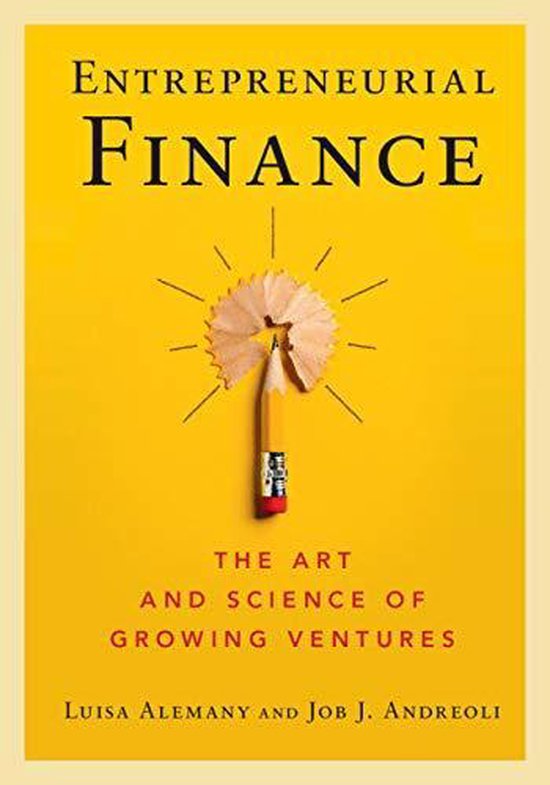Summary Entrepreneurial Finance
Session 1: Introduction
= Fundamental problem covered in this course:
• Entrepreneurs = very optimistic and believe
in their invention.
• Investors = pessimistic, sceptical, critical
Typical CF-pattern of a start-up company:
First months: negative CF → it takes some
time before you operate breakeven. You
are burning a lot of money. → you (may)
need funding = topic of this course.
How long it takes depends on the industry
and the company.
Examples: Biocartis, Deliveroo (& Uber), Collibra, TravelBird
Nowadays, it is easier for entrepreneurial companies to raise money. (Except for the
uncertainty caused by the Ukrainian war)
2023:
o Only companies that perform well still find money against decent valuations. Those
who do not meet that selection do not find money. It has become all or nothing.
o The problem is especially in the later financing rounds (the larger D and E rounds).
There is still money in the early stages of financing. The search takes longer, but the
money is there. The market for the larger rounds, on the other hand, has completely
collapsed, mainly because there are no exit opportunities today against the
valuations that were paid in 2021-2022. This weighs on the venture capital industry.
o Investors have become more selective and are now focusing on profitability more
than on growth.
o Sequoia also expects valuations to normalize as interest rate cuts occur. In other
words, spring may be in the air.
,“Belgian start-ups raising a record amount of capital. Great to see but don't get blinded by raising as
much as possible. The right amount from the right investor(s) at the right time will still take you
further.”
Raising lots and lots of capital may lead you to be less creative and just start spending it on
useless things like an extra luxury hotel room when going to business conferences.
Key questions in entrepreneurial fundraising:
How much money do you need?
➢ Do you need money? What is the impact of business model design on your
funding needs?
➢ How to avoid dilution while maximizing value?
When do you need the money?
➢ Trajectory to stay funded (don’t raise money on the moments you don’t need
it: it’s costly!)
What type of investors to target?
➢ From accelerators to angels up to VC to end with IPO?
How to provide attractive returns?
➢ What type of financial instrument?
➢ How to price your company at each stage? (= valuation)
How to approach investors and how to pitch to investors?
➢ Remove the mystique and give insights on the process
“The biggest challenge for many entrepreneurs is not raising large amounts of outside money, but
having the wits and hustle to do without it”
“That you can always win, even from an underdog position, and that creativity and imagination
are powerful weapons.”
"Opportunities don't happen, you create them."
Bootstrapping—starting and growing a business without outside funding—allows founders to play by
their own rules.
,1. Setting the stage
= Many entrepreneurial companies (left) and different kinds of investors (right).
Since the 1920s, the number of listed companies in Belgium has dropped significantly, from more
than 1000 to less than 150 today.
2,1 million privately held companies today.
Demonstrates the importance of entrepreneurial finance! (non-listed, private companies)
Entrepreneurial finance:
• Valuing and financing unquoted entrepreneurial companies
• Making deals
• Financial decision making by entrepreneurs who are undertaking new ventures
o New ventures are broader than just new businesses, but they are often the main
focus.
▪ Startups, new entrepreneurial ventures within an existing business,
acquisition of an existing business.
o corporate finance: financial decision making by managers of public companies
“The art and science of investing and financing entrepreneurial ventures”
• In the first year, you will most likely not yet make a lot of revenues: it is a year full of
expenses! → funding needed!
• Estimating the resources needed to make your dream a reality.
• Recently emerged field at the crossroads of entrepreneurship and finance.
, o Entrepreneurship = discovering an opportunity and the steps that need to be taken
to make it a reality.
o Finance: obtaining money, investing money and understanding the cost and the best
use of money.
▪ Investing: where to invest budgets?
▪ Financing: where to get the money needed to invest?
• Typically mainly private funding.
o corporate finance: public funding.
• Entrepreneurial finance also involves social businesses without a profit goal, however
financial stability is a must.
EU fact and figures:
23 million existing companies
2 million companies created a year
200.000 of the start-ups (Bannock):
are growth oriented
might offer a sufficient, but not extra-ordinary return
20.000 high-growth start-ups
Some 3.000 get Venture Capital
Less than 2 out of 1.000 start-ups get VC in the EU! (relatively small number!)
As 90% of financing for business is debt, why does most of this course focus on equity and
valuation?
To answer: define an entrepreneur:
“An entrepreneur is someone who exercises business judgement in the face of uncertainty”
(Cantillon, 1755)
“Entrepreneurship is characterized by the existence of new combinations
causing discontinuity… The process of creative destruction…”
(Schumpeter, 1936)
“The ability to discover new ways of dealing with known problems or new combinations of given
knowledge” (Penrose, 1959)
“Someone who pursues opportunities with no regard to resources currently controlled”
➔ Impossible to provide a profile, but leading psychoanalysts suggest many entrepreneurs do share
characteristics:
1) Opportunity recognition/creation







